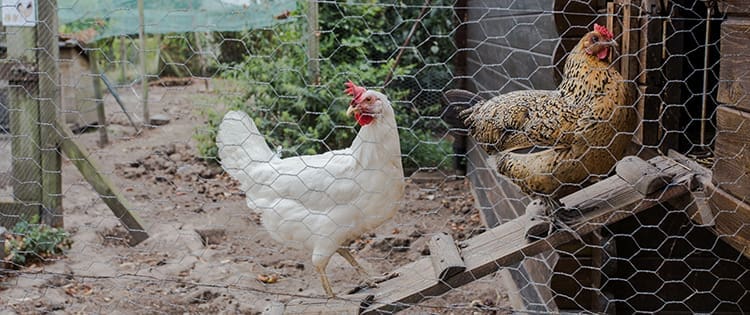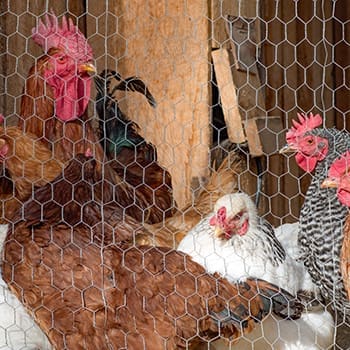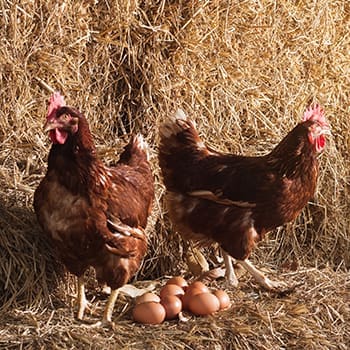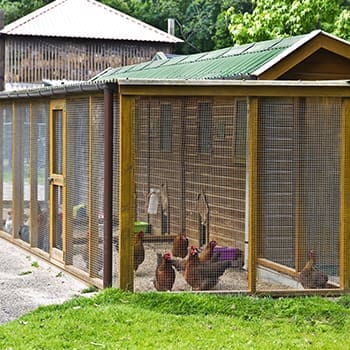It’s easy to raise chickens, and you can do it in the smallest spaces. Six chickens can provide you with six fresh eggs a day, and you always have the option to cook chicken as they mature. It’s the first step that many people take toward animal husbandry. But it comes with some challenges. There are a few important chicken coop mistakes you should avoid at all costs.
I’ve put together two chicken coops, and my son and daughter have their own coops as well. We’ve compared notes on what we’ve done right and wrong, and the results were surprising.
The ultimate benefit of raising feathered friends is that they are the easiest beginning for animal husbandry. You get the benefits of an egg a day from a healthy chicken. Eventually, you also get the meat from the chicken.
One of the most common mistakes is overcrowding. This leads to excess waste accumulation and a constant challenge related to sufficient feeding and water. But it can get more complicated.
Chicken Coop Mistakes You Should Avoid at All Costs
Average Space Per Chicken 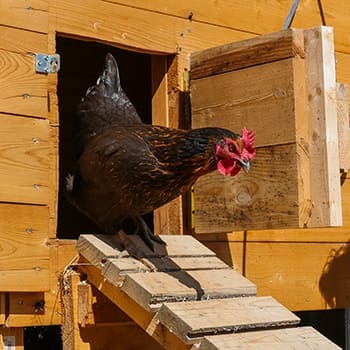
It’s not just about a coop design, but the chicken run as well. This is an area where the chickens can roam about.
As a general rule, plan for at least 3 to 5 square feet for each chicken in the coop. In the chicken run area, allow for at least 10 square feet per chicken. If you don’t do this, the chickens will be overcrowded, so make sure to create the perfect chicken living space. Avoiding chicken coop mistakes like this ensures a healthier flock.
The other thing to make sure of is effective watering. Have a watering system both in the coop and in the run. Chickens will peck and find food, but they need easy access to water.
Chicken Coop Mistakes: Protection from Predators
It’s easy to assume that wolves and foxes will be the greatest threat to your chickens, but in reality, the family dog or neighbor’s dogs pose the biggest danger. Whatever you do, you must protect your flock.
Make sure your coop and run are well protected and don’t rely on chicken wire—it won’t stop determined animals. Make sure your coop is essential for predator-proofing to keep them safe from predators.
It’s not just dogs you have to worry about. Rats, raccoons, hawks, and even snakes can get in if you don’t reinforce weak points.
Use ½-inch hardware cloth instead of chicken wire, and bury fencing at least 12 inches deep to stop digging predators. Also, secure the top of the run since chickens can fly just enough to escape, making them easy targets for aerial predators. I also recommend these DIY automatic traps for chicken predators, which are completely safe for your chickens.
Overcrowding 
Respect the amount of space a chicken needs both in the coop and the run. It’s always tempting to add more chickens, but if you can’t expand the space, don’t expand the flock. Overcrowding causes stress, feather pecking, and disease, which can spread quickly in tight spaces.
Each hen needs at least 4 square feet inside the coop and 10 square feet in the run to stay healthy and comfortable. More space is always better, as it allows chickens to establish a natural pecking order, forage, and exercise without constant competition.
Chicken Coop Mistakes: Lack of Effective Cleaning
Chickens are messy animals, and their droppings end up everywhere—from the coop floor to nesting boxes, water trays, and food bowls. If not managed, ammonia fumes from their waste can build up and harm your birds over time.
Stay on top of cleaning by scooping droppings regularly and adding them to the compost heap—they make excellent fertilizer. Neglecting this is one of the most common chicken coop mistakes that lead to unhealthy conditions.
To keep the coop healthy, use the deep litter method or regularly clean weekly, sprinkle diatomaceous earth to prevent mites, and ensure your coop is essential to be easy to clean.
Water and Food
Food is the easy part, but water is often the biggest challenge in any coop. Specialized watering setups hold plenty of water and let chickens drink as needed, but placement matters.
Keep food off the ground to prevent rodents, and position water away from roosting areas to avoid contamination from droppings. Clean water is just as important as food for a happy healthy flock. Ignoring proper placement is another one of those chicken coop mistakes that can lead to health issues.
There are a lot of things you can feed your chickens, but there are also many other plants that they can safely consume. In fact, you can feed them this plant, which will double the egg production of your flock and grows almost everywhere in America.
Forgetting to Harvest the Eggs 
Most of us don’t forget to harvest fresh eggs, but it happens. The good news is that eggs in the nesting boxes actually kept without refrigeration. Once they are washed, they need to be refrigerated but don’t forget to gather those eggs.
If you have more than enough eggs, you can learn from the Amish this ingenious method to keep eggs fresh for at least a decade.
Chicken Coop Mistakes: Heating and Cooling
Chickens are surprisingly tolerant of cold temperatures. After all, they’re covered with downy feathers. It’s the heat that is often the biggest challenge.
A solar fan in the hen house can help move air and cool it down, offering them proper ventilation. When it gets very cold, a small space heater can keep them warm during the night.
Bad Chickens
Some common chicken breeds are surprisingly aggressive. They peck at other birds and create havoc in a coop. If you have a bad chicken—kill it.
All homesteaders cook chicken at least once in their lifetime. I know that for some of you, this sounds wrong, but homesteading is not for everyone.
You will eventually harvest your chickens for dinner. The best place to start is with the ones that don’t get along.
Lack of a Chicken Run 
You can’t just coop up a bunch of chickens in a coop. They need room to roam, forage, and just move around. Commercial chicken farms lock them up and force-feed them just to get the eggs and the meat.
A healthy chicken needs some room to roam. Free-range chickens actually produce the healthiest eggs. They are more orange than yellow, and if you can—give them the opportunity to move around. Also, provide space for dust bathing, as it helps keep them clean and free of parasites.
Assessing and Treating Disease
We’ve all heard too much about bird flu, but you need to pay special attention to the health and condition of your chickens. Most chickens infected with bird flu die quickly. If you notice a sudden die-off of chickens in your coop—it’s time to start over.
You can eat chickens that have died from bird flu, but make sure you cook them to at least 160 degrees Fahrenheit. Personally, I wouldn’t eat a diseased chicken, but in survival times, it’s sometimes necessary.
Chicken Coop Mistakes: Failure to Cull
Over time, we sometimes get attached to our feathered friends. We might even start to name them. That’s a mistake. You’re raising chickens for the fresh eggs and ultimately the frying pan or oven.
Mature chickens eventually stop laying eggs. That’s the time to pull them and eat them. That sounds brutal, but eventually, any chicken experiment ends with a chicken in the pan.
Avoiding chicken coop mistakes like failure to cull ensures you maintain a productive and sustainable flock.
Frequently Asked Questions About Chicken Coop Mistakes
1. What is the most common mistake when building a chicken coop?
Many people forget to provide proper ventilation or don’t ensure the coop is predator-proof. These can lead to unhealthy chickens or even lost flocks.
2. Why is my chicken coop too smelly?
A smelly coop is usually due to poor ventilation or inadequate cleaning. Ammonia buildup from chicken droppings is a common issue.
3. How much space do my chickens really need in the coop?
Not giving chickens enough space leads to overcrowding, which can cause stress, fighting, and health problems. Each chicken needs at least 2-3 square feet of space in the coop.
4. What should I do if my chickens are not laying eggs?
Check if your chickens have enough space, proper nutrition, lighting, and a stress-free environment. Also, check if they are too old, as egg production decreases with age.
5. How do I keep predators out of my chicken coop?
Predators like raccoons, foxes, and snakes can easily break into coops if they’re not properly secured. Make sure your coop is sturdy, with secure doors, locks, and a fenced-in run.
6. Is it a mistake to use wood shavings in my chicken coop bedding?
Wood shavings can work well, but if they are too thick or not changed regularly, they can become a breeding ground for bacteria. Make sure to change bedding often and use the right type for your climate.
7. Why are my chickens pecking each other?
Overcrowding, lack of stimulation, and insufficient space in the coop can cause chickens to peck at each other. Ensure they have enough room and things to do to avoid boredom.
Wrapping Up
Raising chickens can be a rewarding experience, but it’s important to remember the purpose behind it.
While they can become lovable pets, it’s crucial to maintain a clear distinction between companionship and practicality. If you want to sustain your flock for optimal egg production, be prepared to make tough decisions when their laying days are over.
What about you? What chicken coop mistakes have you made so far and what did you do after? Let me know in the comments!
These Animals Are Stealing Your Chicken Eggs
How to Take Care of Your Livestock When They Are Sick (Video)
These Are The Most Dangerous Chicken Breeds. Do You Have Any Of Them?

